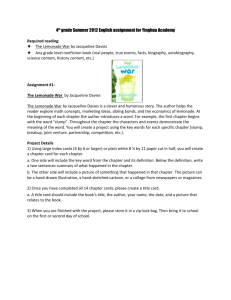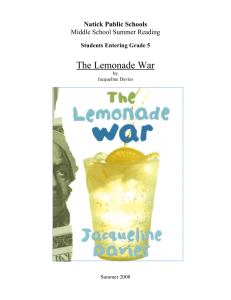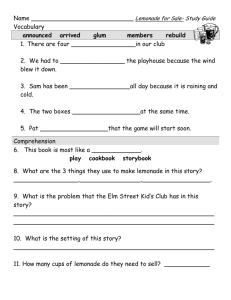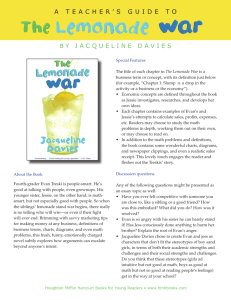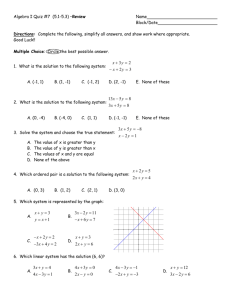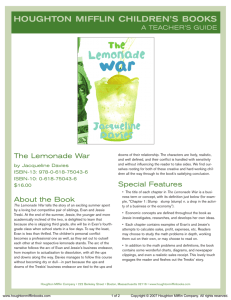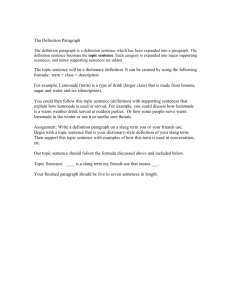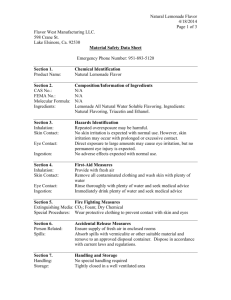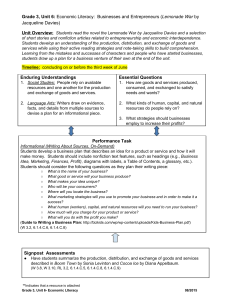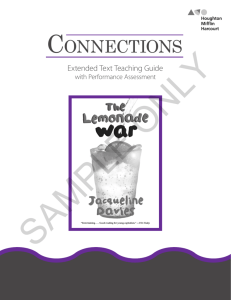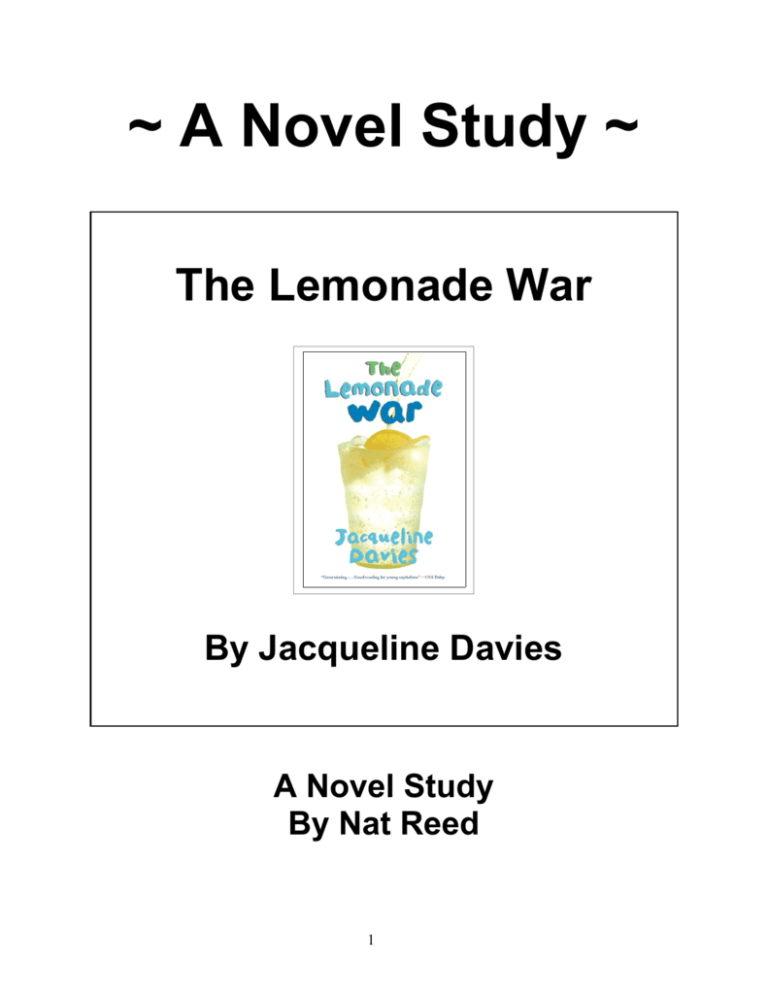
~ A Novel Study ~
The Lemonade War
By Jacqueline Davies
A Novel Study
By Nat Reed
1
The Lemonade War
By Jacqueline Davies
Table of Contents
Suggestions and Expectations ..……………………………………….
3
List of Skills ….……………………………….…………………………..
4
Synopsis / Author Biography …..…………………………………......
5
Student Checklist ………………………………………………………..
6
Reproducible Student Booklet ..………………………………………..
7
Answer Key ...……………………………………………………………...
62
About the author: Nat Reed has been a member of the teaching profession for more
than 30 years. He is presently a full-time instructor at Trent University in the Teacher
Education Program. For more information on his work and literature, please visit the
websites www.reedpublications.org and www.novelstudies.org.
Copyright © 2015 Nat Reed
All rights reserved by author.
Permission to copy for single classroom use only.
Electronic distribution limited to single classroom use only.
Not for public display.
2
The Lemonade War
By Jacqueline Davies
Suggestions and Expectations
This curriculum unit can be used in a variety of ways. Each chapter of the novel study focuses on
one or two chapters of The Lemonade War and is comprised of five of the following different
activities:
•
•
•
•
•
Before You Read
Vocabulary Building
Comprehension Questions
Language Activities
Extension Activities
Links with the Common Core Standards (U.S.)
Many of the activities included in this curriculum unit are supported by the Common Core
Standards. For instance the Reading Standards for Literature, Grade 5, makes reference to
a) determining the meaning of words and phrases. . . including figurative language;
b) explaining how a series of chapters fits together to provide the overall structure;
c) compare and contrast two characters;
d) determine how characters … respond to challenges;
e) drawing inferences from the text;
f) determining a theme of a story . . . and many others.
A principal expectation of the unit is that students will develop their skills in reading, writing,
listening and oral communication, as well as in reasoning and critical thinking. Students will also
be expected to provide clear answers to questions and well-constructed explanations. It is critical
as well that students be able to relate events and the feelings of characters to their own lives and
experiences and describe their own interpretation of a particular passage.
A strength of the unit is that students can work on the activities at their own pace. Every activity
need not be completed by all students. A portfolio cover is included (p.7) so that students may
organize their work and keep it all in one place. A Student Checklist is also included (p.6) so
that a record of completed work may be recorded.
Themes which may be taught in conjunction with the novel include justice and fairness, the
importance of family and friends, perseverance, selflessness, loyalty and trust.
3
The Lemonade War
By Jacqueline Davies
List of Skills
Vocabulary Development
1.
2.
3.
4.
5.
6.
7.
Locating descriptive words / phrases
Listing synonyms/homonyms
Identifying / creating alliteration
Use of capitals and punctuation
Identifying syllables
Identify personification.
Identify singular/plural
8.
9.
10.
11.
12.
13.
Identify anagrams
Listing compound words
Identifying parts of speech
Determining alphabetical order
Identification of root words
Identify/create similes
Setting Activities
1. Summarize the details of a setting
Plot Activities
1. Complete a time line of events
2. Identify conflict in the story
3. Complete Five W's Chart
4. Identify cliffhangers
5. Identify the climax of the novel.
6. Complete a Story Pyramid
Character Activities
1. Determine character traits
2. Identify the protagonist/antagonist
3. Relating personal experiences
4. Compare characters
Creative and Critical Thinking
1.
2.
3.
4.
5.
Research
Write a newspaper story
Participate in a talk show
Conduct an interview
Create a poem
6. Write a description of personal feelings
7. Write a book review
8. Complete an Observation Chart
9. Complete a KWS Chart
10. Create a friendly letter.
Art Activities
1. A Storyboard
2. Create a collage
3. Design a cover for the novel
4. Create a comic strip
4
The Lemonade War
By Jacqueline Davies
Synopsis
Evan Reski is people-smart. He is good at talking to people, even grownups. His younger
sister, Jessie, on the other hand, is math-smart – but not especially good at understanding people.
She knows that feelings are her weakest subject. So when their lemonade war begins, there is no
telling who will win – or if their fight will even end. (The publisher)
“[Davies] does a good job of showing the siblings' strengths, flaws, and points of view in this
engaging chapter book.” ~ Booklist
A complete synopsis and other helpful reviews can be found online at such sites as the following:
http://www.amazon.ca/The-Lemonade-War-Jacqueline-Davies/dp/0547237650
Author Biography
Jacqueline Davies
I've always loved to write stories and poems. In fact, I
wrote my first book when I was in elementary school. It was
called "The Sad Shape," and it was about a circle who wanted
legs. I still have that book! I bring it with me on school visits to
show that all writers have humble beginnings.
I was born in Cleveland, Ohio, and lived in five states by
the time I was eleven. Moving around so much made me a
student of human nature. You have to pay close attention when
you're always the new kid in town. To this day, one of my
favorite things to do is people-watch. I never get tired of
watching people go by, asking myself, I wonder what the story
is behind that person?
Nowadays, I live in a small town about twelve miles
outside of Boston, Massachusetts. I have three kids and one
dog, and they're all pretty terrific. When I'm not busy with my kids and my writing, I like to
read, go to movies, watch the Celtics and the Patriots, travel, and hang out with my friends.
Sometimes, though, I just sit on my front steps and watch the people go by.
Courtesy of http://www.jacquelinedavies.net/about.html
5
The Lemonade War
By Jacqueline Davies
Student Checklist
Student Name:
Assignment
Grade/Level
6
Comments
The Lemonade War
By Jacqueline Davies
Name:
7
The Lemonade War
By Jacqueline Davies
Chapter 1
Before you read the chapter:
The protagonist in most novels features the main character or “good guy”. There are
actually two protagonists in The Lemonade War, Evan Treski and his younger sister,
Jessie. Think back on some of your favorite characters from past novels you have read
or movies you’ve seen. What do you think makes for an especially interesting
protagonist?
Vocabulary:
Choose a word from the list to complete each sentence.
complicated
direct
humiliated
humungous
disgust
genius
installed
economy
1.
Jasmine felt quite ____________ when she fell off the swing.
2.
Slump is defined as a drop in the activity of a business or the ____________.
3.
Kevin was filled with ____________ when he saw April bullying her younger sister.
4.
Paula woke up to discover that she had a ____________ red pimple on her nose.
5.
“The instructions are much too ___________ for such a young person,” Mr. Hunter said.
6.
I doubt if there is a ____________ route from Brisbane to your cottage.
7.
While we were away for the holidays our neighbors ____________ a huge satellite dish
on their roof.
8.
Most people consider Albert Einstein to be a ___________.
8
Questions
1. What is the setting of the story at the beginning of Chapter One?
2. What were the following people doing as our novel begins?
Evan
Evan's Mom
3. Describe how Evan was feeling about his younger sister in this chapter. What had made
him feel this way?
b. If you were Evan in this situation, would you feel the same way? Why or why not?
4. What two pieces of evidence do we have in this chapter which tell us that Jessie must be
quite smart?
1
2
5. How did Jessie make things worse after Evan was hit in the nose with the ball? (Maybe
she's not so smart after all.)
9
Good to Know ~ Stratego
Jessie informs us that Evan's favorite game is Stratego, a popular
strategy board game for two players. The origins of Stratego can be
traced back to the traditional Chinese board game Jungle, also known
as "Game of the Fighting Animals". The modern game of Stratego was
originally manufactured in the Netherlands and was introduced in the
United States in 1961. The game is particularly popular in the
Netherlands, Germany and Belgium where regular world and national
championships are organized. The web site, List Challenges, ranks
Stratego as the world's 15th most popular board game.
Language Activity
A. Anagrams
An anagram is a word that is formed by changing the order of the letters of another
word. For example, the letters in the word WAS can also form the word SAW. Follow
these directions to form the anagrams:
a) read the clue in the right-hand column.
b) Using the word in the left-hand column move the letters around in any order, but you
must use all the letters.
Word
Anagram
Clue
palm
Provides light.
nose
Great periods of time.
step
Someone who is a bother.
elbow
Underneath
dim
Center
deal
To direct someone.
shut
Small buildings.
10
B.
Place the following words from this chapter in alphabetical order.
face
1.
figure
2.
eyes
3.
flame
4.
fort
5.
game
6.
felt
7.
feel
8.
Evan
9.
fighting
10.
C.
Onomatopoeia is the formation of words whose sound imitates the sound of a
noise such as hiss, buzz, and bang. There are at least five examples of onomatopoeia
in Chapter One. See if you can find three examples of this literary device and then tell
what each sound represents.
The Sound
It is the sound of ...
1
2
3
Invent your own examples of onomatopoeia and then tell us what sounds they
represent.
The Sound
It is the sound of ...
1
2
3
11
Extension Activities
A. Storyboard
A storyboard is a series of pictures that tell about an important event in a story. A storyboard can tell the story of only one scene – or the entire novel. Complete the storyboard below illustrating the events described in this section of The Lemonade War.
You may wish to practice your drawings on a separate piece of paper.
1
2
3
4
5
6
12
B. Poems Evan and Jessie Would Probably Enjoy.
Marian wrote the following Haiku poem about lemonade:
Lemonade
Lemonade in hand
Sipping it in the cool shade
It cools me off now
(hellopoetry.com)
Haiku is a Japanese poetry form. A haiku uses just a few words to capture a moment
and create a picture in the reader's mind. It is like a tiny window into a scene much
larger than itself.
Traditionally, haiku is written in three lines...
~ with five syllables in the first line
~ seven syllables in the second line
~ and five syllables in the third line.
The Haiku Poem
Now create your own Haiku Poem on a subject of your choice. Your poem must follow
the format of a haiku poem described above (and doesn't need to rhyme).
Title: _______________________________________________
13

